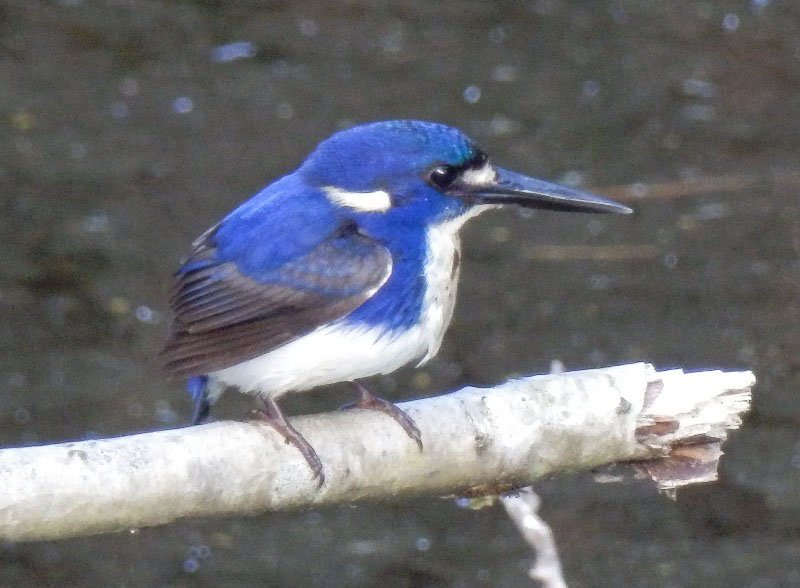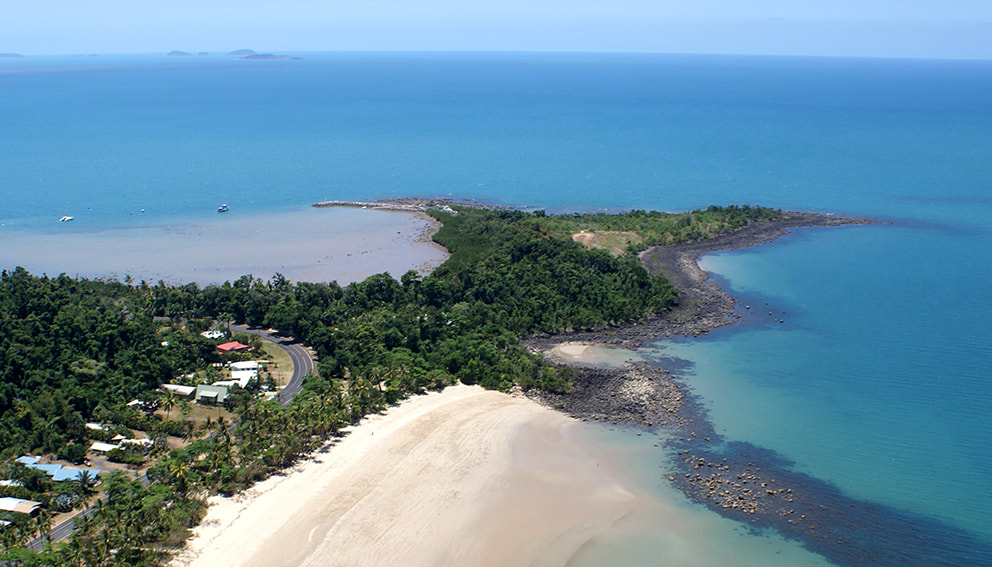| WILDWATCH by ANNE WILKINSON. I will never forget our first sight of the little kingfisher. Yes, that really is its name, and it is tiny. Indeed, it is hard to picture a kingfisher which is only 12 centimetres long, but that is all this little gem is. This measurement includes its strong, black beak. It is Australia’s smallest kingfisher, and its latin name is almost as long as it is, Ceyx pusillus. But back to that wonderful sighting. |
PATIENCE: Sitting, quietly watching the water below a pond at Coquette Point for something edible, this little kingfisher, Australia’s smallest, provided a wonderful subject for Yvonne Cunningham’s camera.
Neither Lawrie nor I had ever seen one of these tiny birds before, so imagine our surprise when there it was perched on the veranda rail, small, vivid, glowing royal blue with a white breast and belly. It had a big, dagger-like beak and a tiny stubby tail. It sat there for long enough for me to quickly sketch it before flying off, fast, like a tiny sapphire bullet.
It was early on a dull morning, half mist half light rain. This was well before Cyclone Yasi and the house was surrounded by trees. Close behind, in a deep gulley, a creek runs, and in those days the trees leaned in to almost cover it. The water is very clear, and tiny fish are visible darting over the sandy bottom.
This was where this tiny bird must have its hunting ground.
The bird book was consulted. We read it was rare, or at least not often seen, usually solitary, and usually sedentary, a little bird which preferred its own company in deep forest, Mackay being its most southerly range.
A creek is essential to its wellbeing, indeed the books tell us its habitat is confined to streamside vegetation.
Despite its tiny size it is a typical member of the kingfisher family, which of course includes kookaburras. It perches on a low branch over the water and watches intently waiting for prey to swim or wriggle by, then it dives, seizes it and takes it back to its perch to demolish it.
When it is hunting, it is concentration personified. It mainly feeds on small fish, crustaceans, and aquatic insects.
As for nesting, it too follows family tradition.
The birds forsake their solitary existence in the mating season and the pair work together on the nest, using their beaks. This is a tunnel drilled some 15 centimetres into the creek bank or a low termite mound. The end is carefully enlarged to form a small nesting space.
The breeding season takes place in the wet season, usually between October and March, and each pair may, it is believed, rear two broods in a season. Five or six tiny, round, pure white eggs are laid, but as with so many bird species , not much else is known. What are the chicks fed on? How long do they take to fledge? How long before they learn to hunt and dive like their parents?
How many survive the difficult period when they are learning to feed themselves? What are the dangers these tiny birds must face up to in their life, and, for that matter, what would be their average lifespan?
The questions are endless, but our little fellow came back on several occasions to our deck, possibly to watch activity in the big lily-filled water bowl nearby.
Then we didn’t see it again. Our fear was that it might have been taken by a snake or a black butcher bird.
Whatever the reason, we missed its jewel-like presence, and it had been a privilege to know it lived on our creek, even if we did not know for how long.
We haven’t seen any sign of little kingfishers at Wildwatch since the cyclone, though azure kingfishers have returned.
This picture was taken by Yvonne Cunningham just last week when she spotted a little kingfisher sitting on a branch above a pond in her garden.
She watched it for a quite a while, long enough to get this fantastic shot.
It dived into the water, came out with something in its beak, ate it, then settled down to watch again, soon repeating the process.
Like us, Yvonne said she was very excited at having seen this reclusive little bird, and being able to watch it while it hunted.
Like us, too, she was delighted by its fantastic, vivid colour.
This truly is one of the little beauties of the wild world.
It was early on a dull morning, half mist half light rain. This was well before Cyclone Yasi and the house was surrounded by trees. Close behind, in a deep gulley, a creek runs, and in those days the trees leaned in to almost cover it. The water is very clear, and tiny fish are visible darting over the sandy bottom.
This was where this tiny bird must have its hunting ground.
The bird book was consulted. We read it was rare, or at least not often seen, usually solitary, and usually sedentary, a little bird which preferred its own company in deep forest, Mackay being its most southerly range.
A creek is essential to its wellbeing, indeed the books tell us its habitat is confined to streamside vegetation.
Despite its tiny size it is a typical member of the kingfisher family, which of course includes kookaburras. It perches on a low branch over the water and watches intently waiting for prey to swim or wriggle by, then it dives, seizes it and takes it back to its perch to demolish it.
When it is hunting, it is concentration personified. It mainly feeds on small fish, crustaceans, and aquatic insects.
As for nesting, it too follows family tradition.
The birds forsake their solitary existence in the mating season and the pair work together on the nest, using their beaks. This is a tunnel drilled some 15 centimetres into the creek bank or a low termite mound. The end is carefully enlarged to form a small nesting space.
The breeding season takes place in the wet season, usually between October and March, and each pair may, it is believed, rear two broods in a season. Five or six tiny, round, pure white eggs are laid, but as with so many bird species , not much else is known. What are the chicks fed on? How long do they take to fledge? How long before they learn to hunt and dive like their parents?
How many survive the difficult period when they are learning to feed themselves? What are the dangers these tiny birds must face up to in their life, and, for that matter, what would be their average lifespan?
The questions are endless, but our little fellow came back on several occasions to our deck, possibly to watch activity in the big lily-filled water bowl nearby.
Then we didn’t see it again. Our fear was that it might have been taken by a snake or a black butcher bird.
Whatever the reason, we missed its jewel-like presence, and it had been a privilege to know it lived on our creek, even if we did not know for how long.
We haven’t seen any sign of little kingfishers at Wildwatch since the cyclone, though azure kingfishers have returned.
This picture was taken by Yvonne Cunningham just last week when she spotted a little kingfisher sitting on a branch above a pond in her garden.
She watched it for a quite a while, long enough to get this fantastic shot.
It dived into the water, came out with something in its beak, ate it, then settled down to watch again, soon repeating the process.
Like us, Yvonne said she was very excited at having seen this reclusive little bird, and being able to watch it while it hunted.
Like us, too, she was delighted by its fantastic, vivid colour.
This truly is one of the little beauties of the wild world.









 RSS Feed
RSS Feed